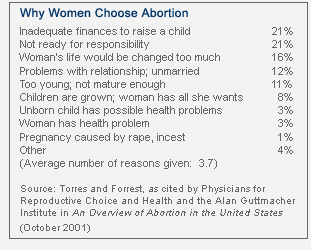Are you thinking about having an abortion or do you know someone who is? Perhaps that's why you are visiting this website or maybe you're simply curious. Whatever the reason, you'll find the information that follows straightforward and factual regarding the medical aspects of induced abortion. If you are considering having an abortion or advising someone else to have one, please consider the facts. There are alternatives that may be safer and healthier – both physically and emotionally – for both you and your child. Before making a decision that could change your life forever, it only makes sense to get all the information you can on the procedure and its potential effects on you and the child you carry.
 When people talk about abortion, one is likely to hear a great deal about the social, moral, and even religious reasons for having or not having an abortion, but little about the basic medical details. In fact, many women make the decision to have an abortion without discussing the medical procedures or the health considerations with anyone. Perhaps no other medical procedure is performed with such a lack of information.
When people talk about abortion, one is likely to hear a great deal about the social, moral, and even religious reasons for having or not having an abortion, but little about the basic medical details. In fact, many women make the decision to have an abortion without discussing the medical procedures or the health considerations with anyone. Perhaps no other medical procedure is performed with such a lack of information.
It doesn't have to be that way. American citizens have a right to be informed about circumstances that might affect their health. There is no reason why any woman should go through surgery of any kind, especially induced abortion, or take powerful drugs that induce abortion, and not even be informed about potentially serious side effects.
The term “abortion” actually refers to any premature expulsion of a human fetus, whether naturally spontaneous, as in a miscarriage, or artificially induced, as in a surgical or chemical abortion. Today, the most common usage of the term “abortion” applies to artificially induced abortion, which is the subject of the following pages.
In 1973, the Supreme Court handed down its Roe v. Wade and Doe v. Bolton decisions legalizing abortion in all 50 states during all nine months of pregnancy, for any reason, medical, social, or otherwise.1 The vast majority of all abortions performed today are done for social, not medical reasons – because a woman cannot afford to have the child, because a woman doesn't feel ready for a baby at the time, because her partner wants her to have an abortion, etc. Approximately 93% of all induced abortions are done for elective, non-medical reasons such as these.2
Since the 1973 U.S. Supreme Court decisions, it is estimated that there have been more than 40 million abortions performed in the United States. An estimated 1.2 million babies are killed annually by abortion…one baby approximately every 24 seconds.
- Roe v. Wade, 410 U.S.; 113, 163-164 (1973) and Doe v. Bolton, 410 U.S. 179, 191-192 (1973). While Roe declares that the state may proscribe late term abortions in the interest of protecting fetal life after viability, it adds the caveat “except when it is necessary to preserve the life or health of the mother,” which Doe explains is to include not only physical health but mental health, to be understood to include factors such as age, familial status, emotional state, etc.
- Aida Torres and J.D. Forrest, “Why Do Women Have Abortions?” Family Planning Perspectives, Vol. 20, No.4 (July/August 1988). P. 170.

